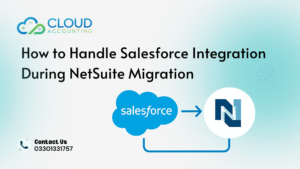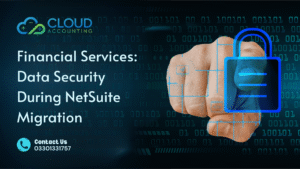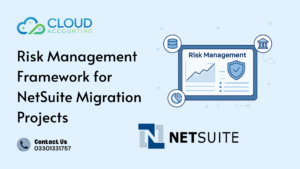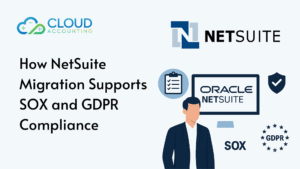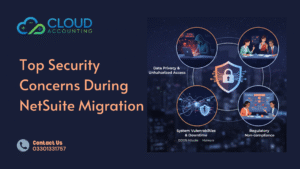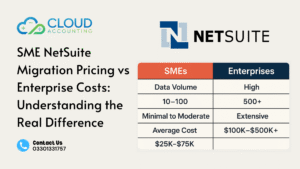When moving business data into a new ERP system, few things are as critical as security. Many organizations focus heavily on functionality and deadlines — but often overlook the invisible threat hiding behind every file transfer, integration, and configuration step. These hidden risks make NetSuite Migration Security Risks one of the most urgent topics for CFOs and IT leaders in 2025.
Every migration involves handling sensitive data — from customer records and financial reports to payroll information. Without proper controls, these records can be intercepted, exposed, or lost during transition. A single breach can cost more than just money; it can damage trust, trigger compliance penalties, and disrupt operations for weeks.
What makes this even more serious is the growing number of cyber incidents linked to poorly managed cloud migrations. According to recent industry reports, misconfigured systems and insecure transfer methods are among the top causes of ERP data breaches worldwide. The good news is that with the right preparation, these risks are preventable.
In this guide, we’ll unpack the top security concerns during NetSuite migration — from data protection challenges to compliance issues — and show how you can minimize exposure with the right safeguards. Whether you’re moving from legacy ERP software or another cloud platform, understanding these NetSuite Migration Security Risks early can protect your business from costly mistakes later.
What Makes NetSuite Migrations Vulnerable to Security Risks?
A NetSuite migration isn’t just a data transfer — it’s a complex process involving multiple systems, users, and third-party tools. Each step introduces new points of vulnerability, and without careful planning, even small oversights can create major security gaps. Understanding what makes migrations risky helps businesses stay ahead of potential threats.
One of the biggest NetSuite Migration Security Risks arises from data movement itself. During extraction, transformation, and import, large volumes of sensitive data flow between servers and storage systems. If this data isn’t encrypted end-to-end, it can be intercepted or corrupted. Many companies still rely on unsecured transfer methods like standard FTP or shared spreadsheets, which increase exposure.
Another frequent source of weakness is misconfiguration. When migration teams rush to meet deadlines, they sometimes assign broad user permissions, overlook access controls, or leave default settings unchanged. These small errors can open the door to unauthorized access once the system goes live.
Third-party involvement adds another layer of complexity. Businesses often use middleware tools or consultants who need temporary access to data. If these external connections aren’t properly managed or revoked, they can become long-term vulnerabilities that cybercriminals
What Makes NetSuite Migrations Vulnerable to Security Risks?
A NetSuite migration isn’t just a data transfer — it’s a full-scale transition involving systems, users, and integrations that handle sensitive business information. Every step introduces opportunities for human error or technical missteps, making security a top concern. Knowing what makes these projects vulnerable helps organizations prepare before trouble strikes.
One of the most common NetSuite Migration Security Risks lies in the data transfer phase. During extraction and import, huge volumes of confidential information — customer details, invoices, employee records, and more — move between systems. If these transfers aren’t encrypted using secure protocols such as SFTP or HTTPS, data can be intercepted or manipulated in transit.
Another weak point is system configuration. When teams rush to meet go-live deadlines, they often overlook security best practices. Admin accounts might be left with default passwords, or permissions may be set too broadly, granting unnecessary access to financial data. These mistakes create backdoors for attackers or unauthorized users inside the organization.
Third-party tools and migration scripts also introduce NetSuite migration security risks. While they speed up the process, many depend on external APIs or temporary logins that can remain active after migration. If not properly disabled, these connections can serve as easy entry points for data theft or ransomware.
Finally, lack of testing and post-migration review makes the environment even more exposed. Without validation steps like vulnerability scanning or audit logging, issues can remain hidden until an incident occurs.
To mitigate these risks, businesses must treat security as a continuous process — not a final checklist item. The next section explores how data protection during NetSuite migration can make or break the success of your ERP transition.
Data Protection Challenges During NetSuite Migration
Protecting data is the most critical — and often the most complex — part of a NetSuite migration. Every record moved between systems carries sensitive financial, customer, and operational information. If proper controls aren’t in place, even one small error can expose the business to major NetSuite Migration Security Risks.
The first challenge comes from data integrity. When information moves through multiple stages — extraction, transformation, and upload — it’s easy for values to become corrupted or mismatched. A single missing field or formatting issue can distort key reports or financial statements. Without validation checks at each step, businesses risk losing the reliability of their accounting data.
Next is encryption. Some companies assume that because NetSuite is cloud-based, their data is automatically secure. But during migration, data often sits temporarily in spreadsheets, local drives, or import tools. If these files aren’t encrypted both at rest and in transit, they become soft targets for cyberattacks.
Another major concern is access control. Multiple users, including consultants or third-party developers, may handle the migration. When credentials are shared through unsecured channels or reused across environments, they increase the likelihood of unauthorized access. Even a temporary oversight in user permissions can lead to data exposure.
Compliance adds another layer of pressure. Industries bound by regulations such as GDPR, SOC 2, or HIPAA must prove that data remains protected throughout the process. Failure to demonstrate due diligence can result in fines or loss of client trust — outcomes that far outweigh the cost of proper controls.
To overcome these challenges, businesses need clear documentation, secure encryption protocols, and ongoing monitoring. Data protection isn’t just about avoiding leaks — it’s about maintaining the integrity and trustworthiness of every financial record you rely on.
Up next, we’ll look at another critical layer of NetSuite migration security risks — user permissions and access management.
User Access & Permission Management Issues
Even with strong encryption and secure transfer methods, one of the biggest NetSuite Migration Security Risks comes from inside the organization — weak access management. When multiple team members, vendors, or consultants handle sensitive data, poorly defined permissions can turn a secure migration into a serious liability.
During migration, businesses often create temporary admin accounts to simplify data import or testing. While this speeds up the process, it also widens access to confidential data. If these accounts aren’t properly monitored or deactivated after migration, they leave open doors for unauthorized entry. Many data breaches stem from old credentials that were never removed.
Another common issue is over-permissioning — granting users more access than they need. For example, giving finance staff full administrative rights during testing might seem harmless, but it increases the potential for errors or malicious actions. Implementing role-based access control (RBAC) ensures each user only sees what’s necessary for their role.
Weak passwords and shared logins also raise significant risks. When credentials are passed around through email or messaging apps, it becomes nearly impossible to track accountability. Multi-factor authentication (MFA) and password management tools should always be enforced before any data migration begins.
Finally, audit trails are often overlooked. Without detailed logs, you can’t track who accessed what, when, or how. This not only complicates troubleshooting but can also create compliance problems if regulators require evidence of secure handling.
In short, access management isn’t just about limiting permissions — it’s about accountability. A well-controlled environment protects both users and data integrity. The next section explores another overlooked part of NetSuite migration security risks: compliance with data protection laws and audit requirements.
Compliance Risks — GDPR, SOC 2, and Beyond
When migrating financial and customer data into NetSuite, compliance is more than just a checkbox. It’s a legal obligation — and one of the most underestimated NetSuite Migration Security Risks businesses face. A single mistake can lead to heavy penalties, reputational damage, and in some cases, legal action.
Regulations like GDPR, SOC 2, and HIPAA require organizations to demonstrate full control over personal and financial data throughout the migration process. That includes showing how information is transferred, stored, encrypted, and eventually verified once it’s in NetSuite. If even one of these steps isn’t documented properly, you could fail an audit or breach compliance laws.
The challenge is that compliance expectations vary depending on where your business operates and who your clients are. For instance:
- UK and EU businesses must meet GDPR standards for data privacy.
- U.S. service providers often follow SOC 2 controls for system security and confidentiality.
- Healthcare companies need to maintain HIPAA compliance when migrating sensitive health-related data.
Many compliance failures occur when companies assume NetSuite automatically covers all security responsibilities. While NetSuite maintains its own certifications, the business itself remains accountable for how data is handled during the migration. Using unsecured file transfers or third-party tools without audit trails can still result in violations.
The key to avoiding these NetSuite Migration Security Risks lies in preparation and documentation. Businesses should conduct a pre-migration compliance review, identify data that falls under regulated categories, and ensure migration partners follow approved frameworks. Post-migration audits can then confirm that no data has been altered, lost, or exposed.
In short, compliance is not something to “check later.” It should guide your migration from day one — ensuring your data remains legally and ethically protected every step of the way.
Third-Party Integration Risks in NetSuite Migrations
Every NetSuite migration relies on a network of tools — data connectors, import utilities, middleware platforms, and sometimes third-party consultants. These integrations make migration faster and more efficient, but they also introduce one of the most overlooked NetSuite Migration Security Risks: dependency on external systems you don’t fully control.
When data passes through third-party tools, it temporarily leaves your direct oversight. Even reputable connectors can log or cache sensitive information such as customer details, financial figures, or employee records. If those systems lack proper encryption or access restrictions, your business inherits their vulnerabilities.
One common example involves middleware used to sync NetSuite with CRMs, ecommerce platforms, or legacy ERPs. These integrations often require persistent API keys or admin-level credentials. If these keys are stored insecurely or shared across multiple environments, they become easy targets for hackers. In some cases, breaches occur months after migration because expired credentials were never revoked.
Another risk comes from unmanaged consultant access. Migration specialists often need short-term login permissions to perform testing, validation, or configuration. Without strict offboarding procedures, those accounts can remain active long after the project ends — creating long-term exposure that’s difficult to track.
To reduce these cloud migration risks, always vet third-party providers before giving them access to your system. Ask whether their tools comply with frameworks like SOC 2 or ISO 27001. Require written confirmation that no client data is stored beyond migration completion. Finally, rotate all API keys, revoke temporary access, and conduct post-migration security audits.
At Cloud Accounting, we take a secure NetSuite implementation approach by isolating client environments, encrypting every transfer, and maintaining a full access log throughout the project. These precautions ensure that third-party efficiency never compromises data safety.
Up next, we’ll discuss proactive ways to avoid these NetSuite migration security risks through industry-proven best practices and expert oversight.
Best Practices to Minimize NetSuite Migration Security Risks
Understanding the dangers is only half the battle — preventing them requires structure, discipline, and the right tools. Whether you’re migrating from QuickBooks, Sage, or a legacy ERP, these NetSuite migration best practices will help you avoid the most common NetSuite Migration Security Risks.
1. Encrypt Everything — at Rest and in Transit
Every file moved between systems should be encrypted using strong standards like AES-256. Avoid sending data through email or unsecured cloud storage. Instead, use SFTP or encrypted APIs that guarantee confidentiality during transfer.
2. Control Who Has Access
Before migration begins, define clear roles and responsibilities. Apply role-based access control (RBAC) so users only see what they need to complete their tasks. Disable all temporary accounts immediately after the project ends. This simple step eliminates many NetSuite Migration Security Risks caused by leftover permissions.
3. Vet All Third-Party Tools and Consultants
If your migration involves external tools or contractors, review their data handling policies. Ask for compliance documentation such as SOC 2 or ISO 27001 certification. Cloud Accounting works only with verified, secure vendors — a key part of maintaining data protection during NetSuite migration.
4. Use a Testing and Validation Environment
Never migrate directly into your live NetSuite account. Build a secure sandbox to test imports, verify data accuracy, and identify configuration issues. This helps catch problems early and protects production data from corruption.
5. Maintain a Full Audit Trail
Track every action performed during migration — from data exports to final validation. Keeping detailed logs supports compliance and ensures accountability. In case of an audit, you’ll have proof that all NetSuite migration security risks were identified and managed properly.
6. Conduct Post-Migration Security Reviews
Once your data is live in NetSuite, perform penetration testing and access audits. Confirm that encryption, MFA, and role settings remain intact. Continuous monitoring turns migration security into a long-term discipline rather than a one-time event.
Following these best practices transforms security from a reactive measure into an embedded culture. At Cloud Accounting, our team applies these controls to every project, ensuring accuracy, compliance, and complete peace of mind.
Next, we’ll show how this approach works in practice — with a real-world example of how Cloud Accounting delivers a secure NetSuite implementation for clients worldwide.
The Cost of Ignoring Security Risks in NetSuite Migrations
Many businesses underestimate the real cost of NetSuite Migration Security Risks until it’s too late. Data loss, breaches, or compliance failures can quickly turn a simple migration into a financial and reputational disaster. What seems like a shortcut during implementation often becomes an expensive recovery effort later.
A single incident of exposed data can trigger immediate consequences — from customer distrust to hefty regulatory fines. For example, under GDPR, fines can reach up to 4% of annual global turnover. Beyond penalties, the hidden costs can include IT downtime, lost productivity, and the expense of forensic recovery. For SMEs, one serious breach can completely derail growth plans.
Security oversights also create operational risks. Missing records, corrupted transactions, or misaligned permissions can disrupt daily accounting and delay decision-making. The more complex the data structure, the harder it is to rebuild trust in reports or reconciliations after an incident.
There’s also the human cost. When employees lose confidence in their systems, morale and efficiency drop. Teams waste time verifying data accuracy instead of focusing on strategic tasks.
Fortunately, these scenarios are avoidable. With proper planning, encrypted transfers, and expert oversight, most NetSuite migration security risks can be eliminated before they appear. Investing in security early costs a fraction of what recovery does later.
Cloud Accounting’s approach ensures migrations are not only accurate and compliant but also resilient against modern cyber threats. Our migration specialists treat every record as critical — because in accounting, every number tells a story worth protecting.
Up next, we’ll close with a simple, action-driven guide to securing your NetSuite migration with expert support.
CTA – Secure Your NetSuite Migration with Confidence
Migrating to NetSuite shouldn’t mean compromising your data security. With the right team and proven safeguards, you can move every record confidently — knowing your information stays protected at all times.
At Cloud Accounting, we help businesses manage and eliminate NetSuite Migration Security Risks through careful planning, encryption, and verification. Our specialists combine deep NetSuite expertise with a structured, security-first migration framework designed to protect sensitive data from start to finish.
Here’s what you gain when you partner with us:
- Certified NetSuite migration experts who understand compliance and data governance.
- End-to-end encryption and secure data handling across every stage of migration.
- Full documentation and audit trails for peace of mind and regulatory compliance.
- Post-migration support, ensuring your NetSuite environment remains secure and optimized.
Ready to protect your data while upgrading to NetSuite? Book a consultation today and get a customized, security-focused migration plan from the Cloud Accounting team.


